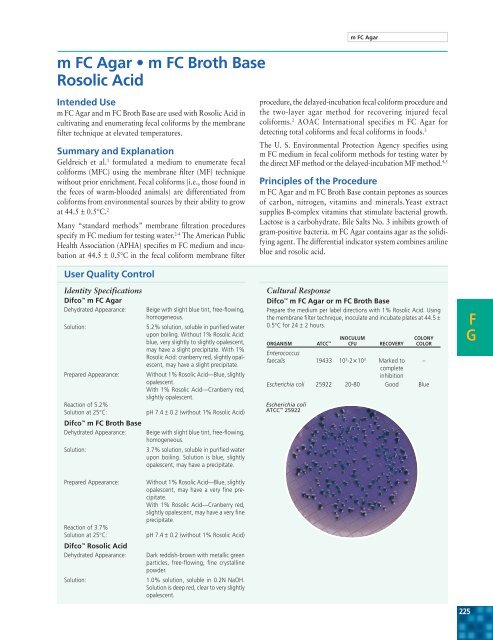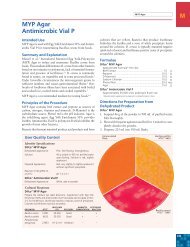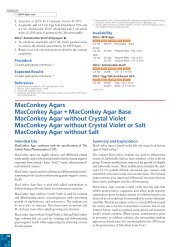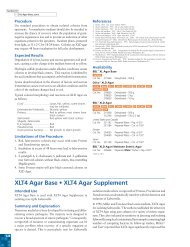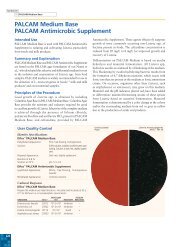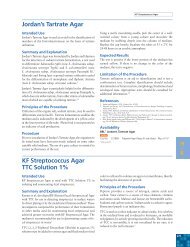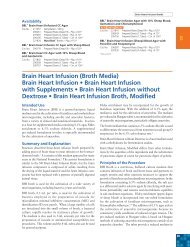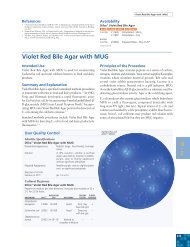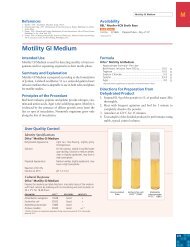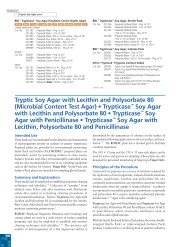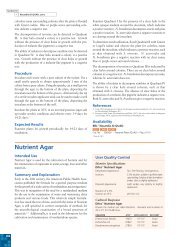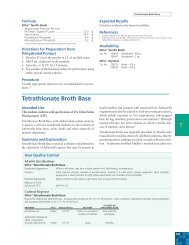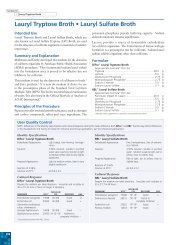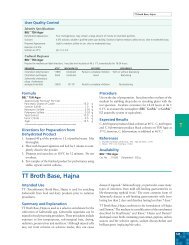F G m FC Agar ⢠m FC Broth Base Rosolic Acid - BVA Scientific
F G m FC Agar ⢠m FC Broth Base Rosolic Acid - BVA Scientific
F G m FC Agar ⢠m FC Broth Base Rosolic Acid - BVA Scientific
Create successful ePaper yourself
Turn your PDF publications into a flip-book with our unique Google optimized e-Paper software.
m <strong>FC</strong> <strong>Agar</strong><br />
m <strong>FC</strong> <strong>Agar</strong> • m <strong>FC</strong> <strong>Broth</strong> <strong>Base</strong><br />
<strong>Rosolic</strong> <strong>Acid</strong><br />
Intended Use<br />
m <strong>FC</strong> <strong>Agar</strong> and m <strong>FC</strong> <strong>Broth</strong> <strong>Base</strong> are used with <strong>Rosolic</strong> <strong>Acid</strong> in<br />
cultivating and enumerating fecal coliforms by the membrane<br />
filter technique at elevated temperatures.<br />
Summary and Explanation<br />
Geldreich et al. 1 formulated a medium to enumerate fecal<br />
coliforms (M<strong>FC</strong>) using the membrane filter (MF) technique<br />
without prior enrichment. Fecal coliforms (i.e., those found in<br />
the feces of warm-blooded animals) are differentiated from<br />
coliforms from environmental sources by their ability to grow<br />
at 44.5 ± 0.5°C. 2<br />
Many “standard methods” membrane filtration procedures<br />
specify m <strong>FC</strong> medium for testing water. 2-4 The American Public<br />
Health Association (APHA) specifies m <strong>FC</strong> medium and incubation<br />
at 44.5 ± 0.5°C in the fecal coliform membrane filter<br />
procedure, the delayed-incubation fecal coliform procedure and<br />
the two-layer agar method for recovering injured fecal<br />
coliforms. 2 AOAC International specifies m <strong>FC</strong> <strong>Agar</strong> for<br />
detecting total coliforms and fecal coliforms in foods. 3<br />
The U. S. Environmental Protection Agency specifies using<br />
m <strong>FC</strong> medium in fecal coliform methods for testing water by<br />
the direct MF method or the delayed-incubation MF method. 4,5<br />
Principles of the Procedure<br />
m <strong>FC</strong> <strong>Agar</strong> and m <strong>FC</strong> <strong>Broth</strong> <strong>Base</strong> contain peptones as sources<br />
of carbon, nitrogen, vitamins and minerals.Yeast extract<br />
supplies B-complex vitamins that stimulate bacterial growth.<br />
Lactose is a carbohydrate. Bile Salts No. 3 inhibits growth of<br />
gram-positive bacteria. m <strong>FC</strong> <strong>Agar</strong> contains agar as the solidifying<br />
agent. The differential indicator system combines aniline<br />
blue and rosolic acid.<br />
User Quality Control<br />
Identity Specifications<br />
Difco m <strong>FC</strong> <strong>Agar</strong><br />
Dehydrated Appearance:<br />
Solution:<br />
Prepared Appearance:<br />
Reaction of 5.2%<br />
Solution at 25°C:<br />
Difco m <strong>FC</strong> <strong>Broth</strong> <strong>Base</strong><br />
Dehydrated Appearance:<br />
Solution:<br />
Beige with slight blue tint, free-flowing,<br />
homogeneous.<br />
5.2% solution, soluble in purified water<br />
upon boiling. Without 1% <strong>Rosolic</strong> <strong>Acid</strong>:<br />
blue, very slightly to slightly opalescent,<br />
may have a slight precipitate. With 1%<br />
<strong>Rosolic</strong> <strong>Acid</strong>: cranberry red, slightly opalescent,<br />
may have a slight precipitate.<br />
Without 1% <strong>Rosolic</strong> <strong>Acid</strong>—Blue, slightly<br />
opalescent.<br />
With 1% <strong>Rosolic</strong> <strong>Acid</strong>—Cranberry red,<br />
slightly opalescent.<br />
pH 7.4 ± 0.2 (without 1% <strong>Rosolic</strong> <strong>Acid</strong>)<br />
Beige with slight blue tint, free-flowing,<br />
homogeneous.<br />
3.7% solution, soluble in purified water<br />
upon boiling. Solution is blue, slightly<br />
opalescent, may have a precipitate.<br />
Cultural Response<br />
Difco m <strong>FC</strong> <strong>Agar</strong> or m <strong>FC</strong> <strong>Broth</strong> <strong>Base</strong><br />
Prepare the medium per label directions with 1% <strong>Rosolic</strong> <strong>Acid</strong>. Using<br />
the membrane filter technique, inoculate and incubate plates at 44.5 ±<br />
0.5°C for 24 ± 2 hours.<br />
INOCULUM<br />
COLONY<br />
ORGANISM ATCC CFU RECOVERY COLOR<br />
Enterococcus<br />
faecalis 19433 10 3 -2×10 3 Marked to –<br />
complete<br />
inhibition<br />
Escherichia coli 25922 20-80 Good Blue<br />
Escherichia coli<br />
ATCC 25922<br />
F<br />
G<br />
Prepared Appearance:<br />
Reaction of 3.7%<br />
Solution at 25°C:<br />
Difco <strong>Rosolic</strong> <strong>Acid</strong><br />
Dehydrated Appearance:<br />
Solution:<br />
Without 1% <strong>Rosolic</strong> <strong>Acid</strong>—Blue, slightly<br />
opalescent, may have a very fine precipitate.<br />
With 1% <strong>Rosolic</strong> <strong>Acid</strong>—Cranberry red,<br />
slightly opalescent, may have a very fine<br />
precipitate.<br />
pH 7.4 ± 0.2 (without 1% <strong>Rosolic</strong> <strong>Acid</strong>)<br />
Dark reddish-brown with metallic green<br />
particles, free-flowing, fine crystalline<br />
powder.<br />
1.0% solution, soluble in 0.2N NaOH.<br />
Solution is deep red, clear to very slightly<br />
opalescent.<br />
225
Section III<br />
FG m <strong>FC</strong> <strong>Agar</strong>, cont.<br />
Colonies of fecal coliforms are blue; non-fecal coliforms and<br />
other organisms are gray to cream-colored.<br />
Formulae<br />
Difco m <strong>FC</strong> <strong>Agar</strong><br />
Approximate Formula* Per Liter<br />
Tryptose ................................................................... 10.0<br />
Proteose Peptone No. 3 ............................................. 5.0<br />
Yeast Extract .............................................................. 3.0<br />
Lactose ..................................................................... 12.5<br />
Bile Salts No. 3 ........................................................... 1.5<br />
Sodium Chloride ........................................................ 5.0<br />
<strong>Agar</strong> ......................................................................... 15.0<br />
Aniline Blue ................................................................ 0.1<br />
Difco m <strong>FC</strong> <strong>Broth</strong> <strong>Base</strong><br />
Consists of the same ingredients without the agar.<br />
Difco <strong>Rosolic</strong> <strong>Acid</strong><br />
<strong>Rosolic</strong> <strong>Acid</strong>................................................................ 1 g/vial<br />
*Adjusted and/or supplemented as required to meet performance criteria.<br />
Directions for Preparation from<br />
Dehydrated Product<br />
Difco m <strong>FC</strong> <strong>Agar</strong><br />
1. Suspend 52 g of the powder in 1 L of purified water. Mix<br />
thoroughly.<br />
2. Heat with frequent agitation and boil for 1 minute to<br />
completely dissolve the powder.<br />
3. Add 10 mL of a 1% solution of <strong>Rosolic</strong> <strong>Acid</strong> in 0.2N NaOH.<br />
Continue heating for 1 minute. DO NOT AUTOCLAVE.<br />
4. If necessary, adjust to pH 7.4 with 1N HCl.<br />
5. Test samples of the finished product for performance using<br />
stable, typical control cultures.<br />
Difco m <strong>FC</strong> <strong>Broth</strong> <strong>Base</strong><br />
1. Suspend 3.7 g of the powder in 100 mL of purified water.<br />
2. Add 1 mL of a 1% solution of <strong>Rosolic</strong> <strong>Acid</strong> in 0.2N NaOH.<br />
3. If necessary, adjust to pH 7.4 with 1N HCl.<br />
4. Heat to boiling. DO NOT AUTOCLAVE.<br />
5. Cool before dispensing.<br />
6. Test samples of the finished product for performance using<br />
stable, typical control cultures.<br />
Difco <strong>Rosolic</strong> <strong>Acid</strong><br />
Prepare a 1% solution, dissolving 1 g in 100 mL of 0.2N NaOH.<br />
Procedure<br />
Difco m <strong>FC</strong> <strong>Agar</strong><br />
1. Prepare the agar medium from the dehydrated base according<br />
to the label directions and with the addition of the <strong>Rosolic</strong><br />
<strong>Acid</strong> solution.<br />
2. Pour molten agar, previously cooled to 45-50°C into special<br />
tight-fitting plastic dishes and allow to harden.<br />
3. Roll the membrane filter used to collect the water sample<br />
onto the surface of the agar, so as to avoid the formation of<br />
air bubbles between the filter and the agar surface.<br />
4. Place the dishes in plastic bags and incubate, by immersion,<br />
in a water bath at 44.5 ± 0.2°C for 24 ± 2 hours.<br />
g<br />
g<br />
g<br />
g<br />
g<br />
g<br />
g<br />
g<br />
Difco m <strong>FC</strong> <strong>Broth</strong><br />
1. Prepare the broth medium from the dehydrated base<br />
according to the label directions and with the addition of<br />
the <strong>Rosolic</strong> <strong>Acid</strong> solution.<br />
2. Add 2 mL of the cooled broth to sterile absorbent pads in<br />
special tight-fitting plastic dishes.<br />
3. Roll the membrane filter used to collect the water sample<br />
onto the moistened absorbent pad, so as to avoid the<br />
formation of air bubbles between the filter and the pad.<br />
4. Place the dishes in plastic bags and incubate, by immersion,<br />
in a water bath at 44.5 ± 0.2°C for 24 ± 2 hours.<br />
Expected Results<br />
Colonies of fecal coliforms will be various shades of blue.<br />
Non-fecal coliforms are gray to cream-colored.<br />
Limitation of the Procedure<br />
A few non-fecal coliform colonies may be observed on m <strong>FC</strong><br />
media due to the selective action of the elevated temperature<br />
and the addition of the <strong>Rosolic</strong> <strong>Acid</strong>. It may be useful to<br />
elevate the temperature to 45 ± 0.2°C to eliminate Klebsiella<br />
strains from the fecal coliform group. 6<br />
References<br />
1. Geldreich, Huff and Best. 1965. J. Am. Water Works Assoc. 57:208.<br />
2. Clesceri, Greenberg and Eaton (ed.). 1998. Standard methods for the examination of water and<br />
wastewater, 20th ed. American Public Health Association, Washington, D.C.<br />
3. Horwitz (ed.). 2000. Official methods of analysis of AOAC International, 17th ed. AOAC International.<br />
Gaithersburg, Md.<br />
4. U.S. Environmental Protection Agency. 1992. Manual for the certification of laboratories analyzing<br />
drinking water. EPA-814B-92-002. Office of Ground Water and Technical Support Division, USEPA,<br />
Cincinnati, Ohio.<br />
5. Bordner, Winter and Scarpino (ed.). 1978. Microbiological methods for monitoring the environment:<br />
water and wastes. Publication EPA-600/8-78-017. Environmental Monitoring and Support Laboratory,<br />
Office of Research and Development, U.S. Environmental Protection Agency, Cincinnati, Ohio.<br />
6. Eaton, Clesceri and Greenberg (ed.). 1995. Standard methods for the examination of water and<br />
wastewater, 19th ed. American Public Health Association, Washington, D.C.<br />
Availability<br />
Difco m <strong>FC</strong> <strong>Agar</strong><br />
AOAC CCAM EPA SMWW<br />
Cat. No. 267710 Dehydrated – 100 g<br />
267720 Dehydrated – 500 g<br />
Difco m <strong>FC</strong> <strong>Broth</strong> <strong>Base</strong><br />
EPA SMWW<br />
Cat. No. 288320 Dehydrated – 100 g<br />
288330 Dehydrated – 500 g<br />
Difco <strong>Rosolic</strong> <strong>Acid</strong><br />
Cat. No. 232281 Vial – 6 × 1 g<br />
226


